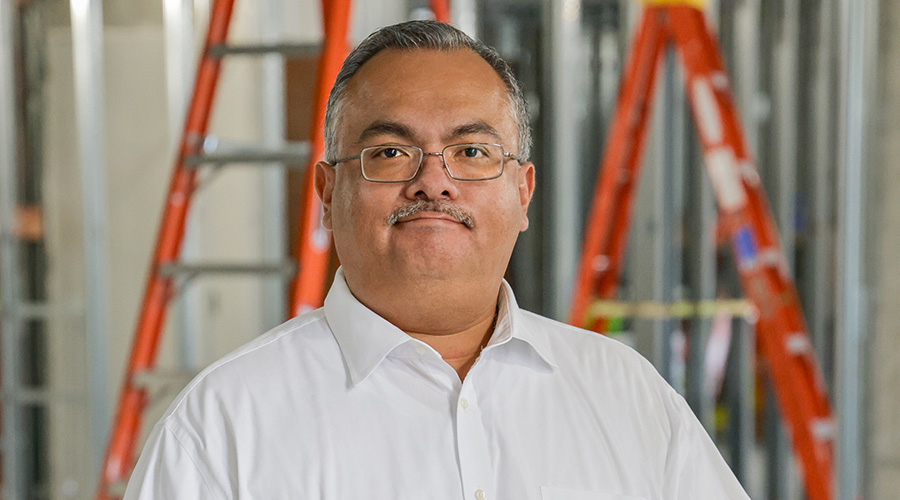Stephen George: Master Planning Via Partnering
By David Kozlowski, Senior Editor
OTHER PARTS OF THIS ARTICLEPt. 1: This Page
On the face of it, Connecticut College’s $53 million dollar capital improvement plan might look like a one-man show. Stephen George is the office of planning, design and construction for the college and is involved in every aspect of a long list of projects from minor renovations and upgrades to major new construction. This former nuclear submarine and military weapons engineer with 23 years of experience at the college, managing its 95 facilities, is certainly up to the task. In his tenure, George has been involved in the design and construction of more than $100 million in projects at this “Little Ivy” school. But he says that if it were just him making the final decisions in a unilateral effort, the projects would not only take more time and money, they would also likely be of a lesser quality.
Of course, the capital improvement plan for the college is not a one-man show, as no set of projects this big could be. George, however, also does not place himself at the center or at the top of this 10-year plan. Instead, he places himself among all the interested parties in each project as an equal. His approach is not top-down managing of projects, it is rather a concerted effort where all stakeholders in the project, from students and faculty to facility staff, are partners and have input into the process of building and renovating the campus facilties and grounds.
So rather than managing projects, he’s really coordinating the input on the construction work, which drastically changes the nature of the design and construction process. That typical top-down, chain-of-command approach is based on a win-lose model or as, George says, the war model where there may be some collaboration but ultimately it’s about winners and losers. “Our world is filled with lawyers today that make a good living navigating the war model,” he says.
The approach he prefers and brought to Connecticut College in 1995 is the partnering model, which is a cooperative approach that harkens back to the day of the handshake deal and is, he says, essential to accomplishing anything within a community of people trying to get things done. It’s a way of working in the world that has a hint of the ’60s culture in it. Partnering in no small way, George says, is his life.
Partnering in design and construction as a project delivery method is a management process in which all stakeholders in a project develop and agree on the project’s goals. Its roots in part reach back into the Army Corps of Engineers and the Associated General Contractors of several decades ago. George says every project done at Connecticut College since he’s been there has used the partnering approach and as result he’s never had to involve a lawyer in his work and wants to keep it that way.
His approach, simplified here, is based on a three-legged-stool model where each leg is as important as the other. The first leg is to bring everybody together, designers first and then all other parties involved in the process. A mission statement is drawn up even before any designs are discussed. Stakeholders put into this document what they think is important. The mission statement is agreed upon by the whole group. It’s important to note that this is not contract, but it is nonetheless critical to what and how things are done, George says. “It’s the first step in what partnering is really all about and that is relationship building,” he says.
The next two legs are to develop an issue plan that addresses the major challenges of the project, and then to develop a partnering council made up of representatives from all the stakeholders, from the contractors, chancellor’s office, students to the all levels of the facility staff. This council meets weekly, “taking the spiritual temperature of the process itself and addressing any concerns immediately,” he says.
This idea of partnering, George says, is not a new idea really. “It’s the way we used to do things — handshake deals, talking over issues and heading off problems before they occur,” he says. “Partnering takes time and time is money but so do legal disputes and haggeling over contract language.”
There are plenty of potential headaches and issues with the school’s 10-year Asset Reinvestment Program, a program George expects to continue beyond it’s 2013 deadline. More than half way through the $53 million in funding, the construction includes new buildings, renovated classrooms, landscaping — every physical aspect of the 100-year-old campus. The first few summers of the program, which began in 2003, had George and his partners managing 100 projects in 17 weeks. There were plenty of opportunities for tempers to flare but frequent meetings before beginning construction and as the work was being done helped keep criticism that wasn’t constructive in check and projects on schedule and within budget.
And the work continued, albeit at a slower pace. In 2008, the school did $9 million in the Asset Reninvestment Program work, including renovations and lots of deferred maintenance. What those first handfuls of hectic summers did was to test the partnering process. It and everyone survived, George says, but just the same he opted for a slower pace going forward in part because $30 million has been spent so far and there’s at least one major new construction project coming up in 2012. In 2010, the school did less than half the number of projects of those first few summers. “It was too stressful.” In 2011, the partners have targeted about $2 million of ARP work.
The work the school is undertaking and calling it asset reinvestment points to the future oriented nature of the program, George says. Though many of his colleages would call the work deferred maintenance, because much of it is work that should have been done, it’s really about building a campus for the future.
And his modus operandi, partnering, is also future oriented. It’s about building relationships in his private life and with his work that create continuity and continuity which builds trust, he says. Having trust in the people he works and lives with makes his life, and all the work the school does, better. Partnering is all about the future, he says.
“Today higher education campuses have fragmented a lot of the functions and out sourced a lot of jobs,” he says. “This creates distrust. Partnering helps break down the barriers and brings everyone together. There’s no distrust because there’s no surprises. Issues are resolved cooperatively. It works and we can all look down the road together.”
Related Topics:











